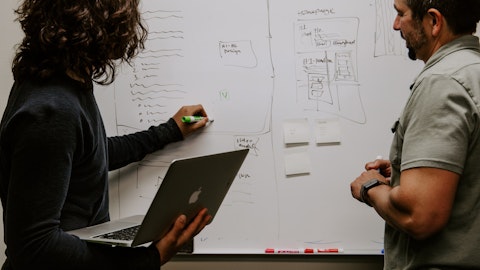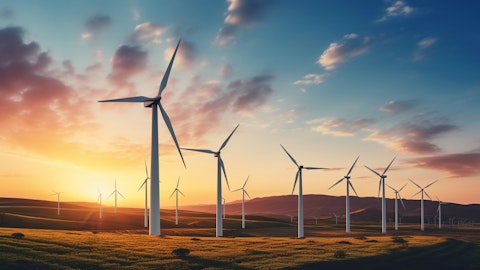Fredrik Stene: Hey, guys, hopefully you can hear me all right, and thanks for the comprehensive color both on the market and outlook for 2024. I wanted to touch a bit upon your fleet and one of your competitors that have reported already. My impression is that for stack assets, there are now more and more opportunities that could make reactivations more sensible than before. So my first question relates to just that. How are you now thinking about your two stacked drillships? Are you building them more actively? Are you only looking at the Meltem for now, or potentially both? And second, you said that the next time we speak, the Maersk acquisition is going to be — the books are going to be closed on that one. So are you planning any more major M&A steps when that’s done? Thanks.
Robert Eifler: Yes, sure. Thanks, Fredrik. First of all, on the drillships, Meltem will be first. That’s the one that we’ve selectively marketed. And I would not say that we’ve really changed our approach in marketing that rig. We’re still looking for a full return on the reactivation costs, which are around $125 million and take a year, maybe slightly longer to carryout. So that continues to be a smaller subset of opportunities, and I think we’ll continue to market into those opportunities. If you just look at the publicly available information through Petrobras or whatever, I think so far we’ve been less willing to provide substantial discounts off of market for that rig. And I don’t see that we’re necessarily going to change our approach of selectively marketing it into opportunities that fit the criteria for reactivation.
And we won’t make — we would not market this Roko until the Meltem has found a job. So we’ll just have to see, I mean it’s a little bit hard to predict when that right job emerges for the Meltem, but we do anticipate that rig going back into the marketplace at some point. On your other question, we’ve said from the very beginning of the announcement of the merger with Maersk Drilling that this was going to be a transformational merger for both companies. And I think that that has absolutely proven out to be the case. We’re extremely pleased with where we sit today. I think our 2023 results, in the midst of some of really the bulk of the integration work, really speak to the combined organization and everyone’s willingness to lean into this and create a sum that is greater than the parts.
So we just couldn’t be more pleased. We have also said that that was going to be our transformational merger and from here, we will be selective. I think it’s obvious that the combined platform could be a candidate for additional M&A. But we are going to be picky, always with a mind to our customers and our investors in what we look at.
Fredrik Stene: Thank you. That’s very helpful. Just a follow-up on the coal stacks and the reactivation thinking. I think you said in your prepared remarks over that for now at least, there’s some supply constraints or some mismatches in terms of where rigs are and where work is. That could make this a relatively balanced market, slightly trending upwards until the sideline capacity is absorbed. So both you and your peers are projecting, I think double-digit number of incremental rigs needed over the next few years. So if that market is going to be balanced and you need that kind of capacity how many — do you have any idea of how many rigs can be brought back from the sideline per year just to see is there a chance that you will have demand outpacing the incremental supply that can be brought back just because of supply constraints, long live items, et cetera. That seems to be delayed or be more difficult to procure at this point than before.
Robert Eifler: Yes, it’s a good question. I mean we’re going to see plus, I think six this year, five or six this year. And we’ve seen plus 15, I believe from the very beginning of this upturn. And so I think the numbers have come through in that kind of five, six, seven at the most per year range, if I’m remembering correctly, and that seems sustainable. It also kind of matches where we see incremental demand, excuse me, coming. I would say a lot of it depends on the specific contracts. There are a couple of more reactivations that are going to occur or contract startups from reactivations that are going to occur in 2024 than we were predicting in early 2023. And that’s partly because some of the tenders extended their start date to allow time for reactivation.
So to the extent that the programs that are out there that are two plus years that the operators of those programs decide to actively include reactivated rigs, a timeline that supports reactivated rigs, I would anticipate as we said in the script that many of the 7 to 10 additional rigs are set up to take discounts to current market. I think this trend probably continues until most of them, if not all of them, but most of them are back into the marketplace. So I could easily see, and that’s kind of why we’ve called for a balanced market over the next year or so. I could easily see the bulk of those 7 to 10 getting announced through, say, mid next year, I mean, just picking a date out of thin air. But it’s not at all impossible that we see a majority of those reactivations getting announced.
The one thing I would say is we’ve been a little bit flat on as an industry on UDW rates over the last six months or so, but the rates have also kind of picked upward even as reactivations have been announced and occurring. And I think that the flatness over the last six months is not necessarily attributable to all of these reactivations. I think it’s a confluence of factors. And all that’s to say that we still do think that there is likely to be rate appreciation through that same period, maybe not at the same slope that we saw early on in this upturn, but we do think that there will be continued rate appreciation.





